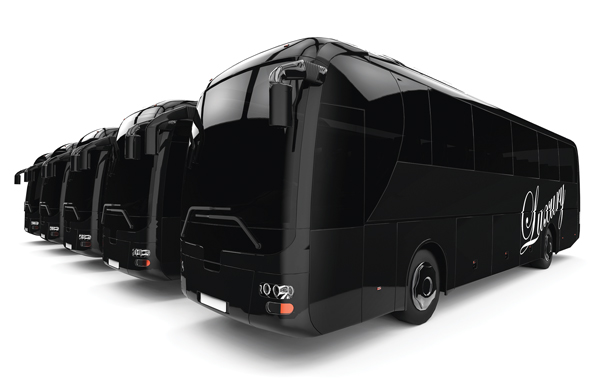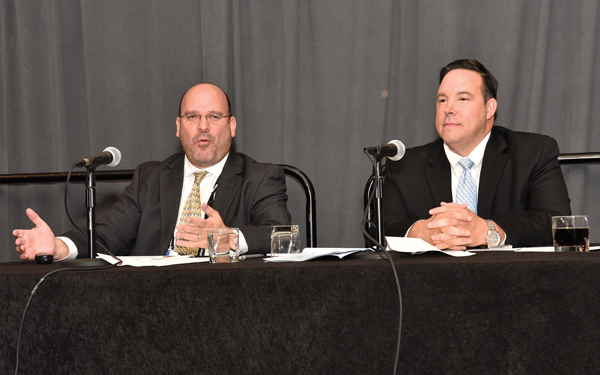BY ROB SMENTEK
 If there is one consistent truth about the chauffeured ground transportation industry, it’s that nothing stays the same. The business regularly faces sweeping changes, requiring operators to frequently shift their tactics and methods, while looking to new means to generate profit.
If there is one consistent truth about the chauffeured ground transportation industry, it’s that nothing stays the same. The business regularly faces sweeping changes, requiring operators to frequently shift their tactics and methods, while looking to new means to generate profit.
Whether it’s a chauffeured 14-passenger bus or a 46-passenger motorcoach manned by a CDL driver, many companies are finding that buses are not only “Uber-proof” but also capable of generating incredible profits in a sector previously unaccustomed to a high level of service.
At the 2016 Chauffeur Driven Show in Washington, D.C., Tony Simon of Reston Limousine and Gray Hill of Black Tie Transportation hosted a seminar entitled Getting On Board With Buses, which provided a series of realistic and practical suggestions to operators looking to expand their services by adding coaches to their fleets. However, there is much more to it than visiting a coach dealer and picking one out after you’ve experienced some success with local farm-out work.
You’ll need to think about the financial implications, insurance, maintenance, staffing, training, and even parking accommodations. For example: Can you park a bus, much less turn it around, in your current lot?
“When you talk about buses, there’s a lot of territory to cover,” said Simon, COO of Reston Limousine. “There are many things to consider. Reston had buses when I first started there, but I did not come from the bus world. I struggled with every part of it: training, maintenance, marketing. It’s ever-changing.”
With firsthand knowledge of the challenges of shifting from farm-out work to investing in a bus, Hill and Simon were able to break down the process into steps to make a potentially overwhelming decision workable. The key to success in each of these steps boils down to one thing: do your homework. Due diligence is a necessity when entering this marketplace, starting with your initial purchase, continuing through the growth of your service and how many you have on the road, and finally—but most importantly—keeping track of your paperwork and DOT compliance. But even if you don’t ultimately decide that purchasing a coach is right for you at this juncture, it’s vital to know these metrics. Simon and Hill emphasize that the differences between the traditional chauffeured ground transportation and bus businesses are big and can be daunting if you don’t have a plan.
 Tony Simon (left) of Reston Limousine and Gray Hill of Black Tie Transportation at the CD Show in D.C.
Know Your Market
Tony Simon (left) of Reston Limousine and Gray Hill of Black Tie Transportation at the CD Show in D.C.
Know Your Market
Before you enter the bus industry, do your research and assess your local market. Simon advocates keeping abreast of what the competition is doing and then determining how you can take advantage of that business. For example, in recent years, he’s seen hundreds of line runs to New York rise in D.C., so needless to say, he added Reston to that emerging market, while being mindful to not outpace the demand.
“Mirror your competitors. Find out what they’re doing. Then figure out how you’re going to compete,” he said.
In addition to scouting and researching the trends in the area, Hill suggests using a valuable marketing resource that’s already at your fingertips: existing clients. “In my case, my market is scattered,” said Hill, president and CEO of Black Tie Transportation. “But we do a lot of corporate and sports team work. We just went to the people we had existing relationships with and introduced them to our new bus side.”
Since these clients were already familiar with Black Tie’s service and no longer had to deal with outside companies through farm-outs, the company’s sterling reputation was the best marketing tool to secure future bus work.
However, your research shouldn’t stop at what your competitors are offering; be aware of what they’re charging, too.
While your instinct may be to attract business by undercutting the other operators in your area, Hill advises to closely study your margins. “Don’t price yourself out,” he warned. “Once you take that step, you don’t want to cost yourself money. Be careful with that.”
Mindful analysis of your profit margins will reveal a “magic number” that will determine whether your profits will pay for your new vehicle but also the feasibility of sustaining that business in the future. But, even with that perfect figure, Hill reminded attendees to not overlook an important fact: “When you move into buses, you’re making a long-term commitment. You could be looking at 7 to 10 years of payments. Are you going to buy or lease?”
The differences between the traditional chauffeured ground transportation and bus businesses are big and can be daunting if you don’t have a plan."
Dollars and Sense
New? Used? Buy? Lease? Clearly, these decisions all rest within your financial ledger. Buying a new bus, Hill says, will get you a great return on investment, particularly if you keep your vehicle well-maintained and turn it over within five years. If leasing is a more realistic option for your business, Simon suggests working closely with your accountant to “get creative” and structure your lease in a manner that is beneficial to your business. Furthermore, you may want to discuss separating your bus and sedan divisions with a financial advisor. This can protect each half from liability, and give you a potential “out” if you decide to sell.
It’s also important to realize that the six-figure number on the sticker isn’t the only fiscal consideration when buying a bus. Everything—and that means EVERYTHING— is exponentially higher in cost, including amenities, parts, labor, and general maintenance.
Simon warns that even companies that have already entered the biz with caution weren’t prepared for the expense that came with it: “There are many companies that bought one or two buses, but weren’t ready for them. They just didn’t have a good system, like when they had a big warranty issue ... With a bus, if you have an issue, it can mean it’s out of service for a month or more ... The payments don’t stop, so you have to plan for that.”
Carefully choosing the right engine and chassis based on the work you plan to do in your market can make all the difference in the world when it comes to reducing maintenance and fuel costs as well as headaches. In some regions, a minibus may not be ideal for frequent long trips, and similarly you don’t want a large coach doing basic shuttle work. It also pays to be prudent to shop around for a manufacturer whose warranty is in effect, not only where the bus was manufactured, but also at other sites around the country.
“We once had a run to Gettysburg where the bus broke down, so we had to get another bus out there,” revealed Simon. “We had to find a farm-out company, which charged us extra; we had to pay a tow vehicle to bring it back; and then we had to fix it. We made zero revenue, but it cost us $8,000. The same applies to minibuses.”
Equally critical to remember are the expenses that go with the amenities of the vehicle. Even if you aren’t outfitting a 46-passenger coach with smart TVs and WiFi, you’ll need to weigh the cost of each and every feature that your bus will offer. Big expenses like wheelchair lifts need to be carefully budgeted (especially if they’re part of your local ADA requirements), but also everything from luggage racks to seats to flooring should be closely examined so that each item not only fits in your budget but also will be around for the long haul. And don’t forget cleaning expenses: buses aren’t going to fit through your local car wash, and the waste from the vehicle’s bathroom requires proper—and frequent—disposal. Coaches also take considerably longer to clean, so you’ll need to factor in additional staff and time to get the vehicle back on the road.
Superior Service
The difference between a mom-and-pop bus company and the chauffeured ground transportation industry comes down to service—and, with that increased level of accommodation, operators are able to attract more business with higher pricing. This simply means that your typical “bus captain” won’t do—and, according to Hill, chauffeur-level service is something that the traditional bus industry is afraid of.
When one of Black Tie’s corporate customers expressed displeasure with the service provided by a farmed-out company, it coaxed Hill into adding a coach to his fleet. “Customers wanted our service to come with the bus. Other drivers were just throwing open the door and ‘saying have a nice day.’ You can train [the service] we already know and put it in the bus side.”
“We’re finding across the board that clients love our level of service [but] training is key,” says Simon. “In our business, anything can happen at any given time. The day starts out one way, but ends with something completely different. Training that flexibility and dynamic approach is why we’re seeing growth.”
But, as we know, service in the chauffeured ground transportation industry extends far past a helpful chauffeur—it includes the reservation and dispatch departments. While the shuttle and bus industry is notorious for its limited Monday to Friday business hours, our industry’s 24/7 existence presents a prime opportunity to grab bookings from clients frustrated or even scorned by small bus companies, and those customers will not only pay more, but they’ll stick with you. What’s more, this puts you in the “big leagues” not only with your existing corporate clients, but DMCs love working with livery companies with buses.
With the chauffeured ground transportation industry in a continuous state of flux, it’s not only beneficial to explore new means of income, it’s mandatory. Adding an executive shuttle, a minicoach, or a bus to your fleet will open you to a whole new world of business opportunities and new client relationships. However, explore all your options and do your homework; buses require due diligence, extensive training, impeccable record keeping, and fiscal responsibility. With the hard work, Simon says, clients will see that size does matter. “Once you have a minibus or coach, the calls will come in. Be prepared.” [CD0417]

